高中英语必修五 语法
- 格式:ppt
- 大小:1.51 MB
- 文档页数:29
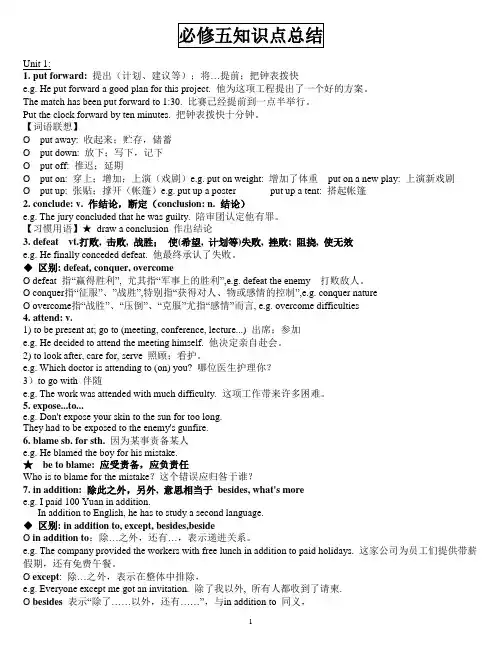
Unit 1:1. put forward: 提出(计划、建议等);将…提前;把钟表拨快e.g. He put forward a good plan for this project. 他为这项工程提出了一个好的方案。
The match has been put forward to 1:30. 比赛已经提前到一点半举行。
Put the clock forward by ten minutes. 把钟表拨快十分钟。
【词语联想】Ø put away: 收起来;贮存,储蓄Ø put down: 放下;写下,记下Ø put off: 推迟;延期Ø put on: 穿上;增加;上演(戏剧)e.g. put on weight: 增加了体重put on a new play: 上演新戏剧Ø put up: 张贴;撑开(帐篷)e.g. put up a poster put up a tent: 搭起帐篷2. conclude: v. 作结论,断定(conclusion: n. 结论)e.g. The jury concluded that he was guilty. 陪审团认定他有罪。
【习惯用语】★draw a conclusion 作出结论3. defeat vt.打败, 击败, 战胜;使(希望, 计划等)失败, 挫败; 阻挠, 使无效e.g. He finally conceded defeat. 他最终承认了失败。
◆区别: defeat, conquer, overcomeØ defeat 指“赢得胜利”, 尤其指“军事上的胜利”,e.g. defeat the enemy 打败敌人。
Ø conquer指“征服”、”战胜”,特别指“获得对人、物或感情的控制”,e.g. conquer natureØ overcome指“战胜”、“压倒”、“克服”尤指“感情”而言, e.g. overcome difficulties4. attend: v.1) to be present at; go to (meeting, conference, lecture...) 出席;参加e.g. He decided to attend the meeting himself. 他决定亲自赴会。
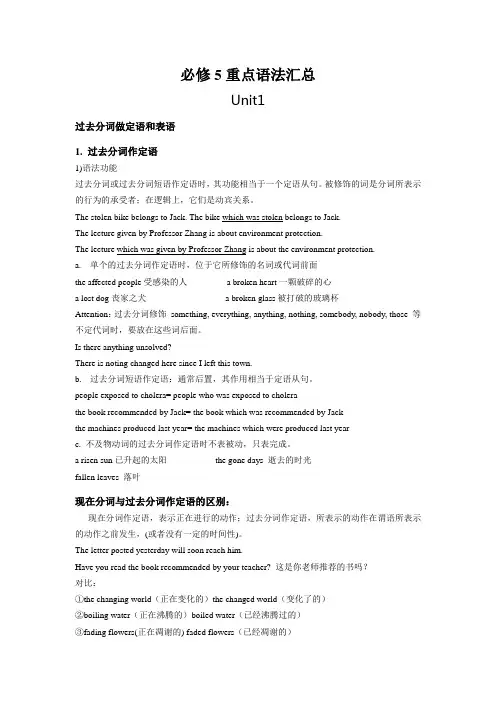
必修5重点语法汇总Unit1过去分词做定语和表语1. 过去分词作定语1)语法功能过去分词或过去分词短语作定语时,其功能相当于一个定语从句。
被修饰的词是分词所表示的行为的承受者;在逻辑上,它们是动宾关系。
The stolen bike belongs to Jack. The bike which was stolen belongs to Jack.The lecture given by Professor Zhang is about environment protection.The lecture which was given by Professor Zhang is about the environment protection.a.单个的过去分词作定语时,位于它所修饰的名词或代词前面the affected people受感染的人 a broken heart一颗破碎的心a lost dog丧家之犬 a broken glass被打破的玻璃杯Attention:过去分词修饰something, everything, anything, nothing, somebody, nobody, those 等不定代词时,要放在这些词后面。
Is there anything unsolved?There is noting changed here since I left this town.b.过去分词短语作定语:通常后置,其作用相当于定语从句。
people exposed to cholera= people who was exposed to cholerathe book recommended by Jack= the book which was recommended by Jackthe machines produced last year= the machines which were produced last yearc. 不及物动词的过去分词作定语时不表被动,只表完成。

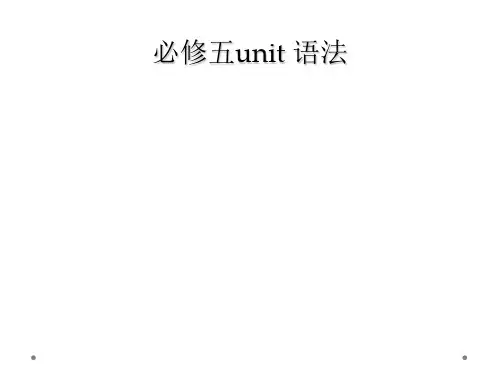
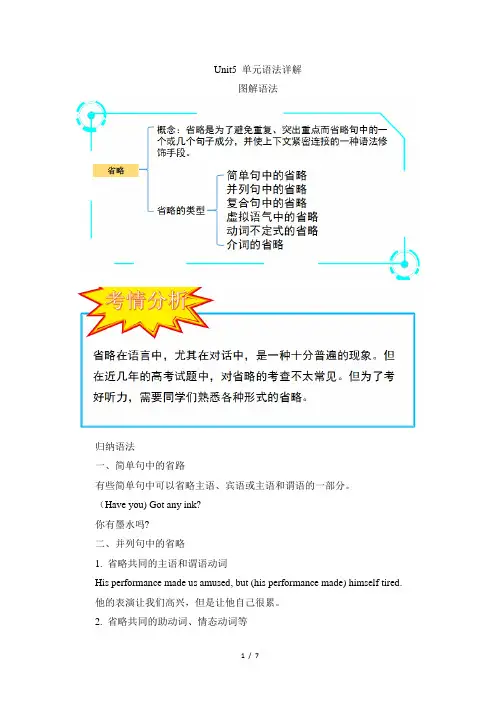
Unit5 单元语法详解图解语法归纳语法一、简单句中的省路有些简单句中可以省略主语、宾语或主语和谓语的一部分。
(Have you) Got any ink?你有墨水吗?二、并列句中的省略1. 省略共同的主语和谓语动词His performance made us amused, but (his performance made) himself tired. 他的表演让我们高兴,但是让他自己很累。
2. 省略共同的助动词、情态动词等Xiaoming must have been playing football at that time, while his sister ( must have been) playing the piano.那时小明一定在踢足球,而他妹妹一定在弹钢琴。
三、复合句中的省略1. 定语从句的省略如果关系代词在定语从句中作宾语,这个关系代词通常可以省略。
Do you remember the place (which/that) we visited last year?你还记得我们去年参观的那个地方吗?He's the man (who/that) you can safely depend on.他是你能放心信赖的人。
2. 宾语从句的省略①及物动词后接宾语从句时,连接词that一般可以省略,但如果及物动词后接两个或两个以上由that引导的宾语从句时,那么只有第一个that可以省略。
He said (that) the text was very important and that we should learn it well.他说这篇课文很重要,我们应该把它学好。
②when,where, how和why引导的宾语从句有时可以仅保留引导词。
I know that a movie star will come to our city but I don't know when (he/she will come to our city) .我知道一个电影明星要来我们城市,但我不知道他/她什么时候来。
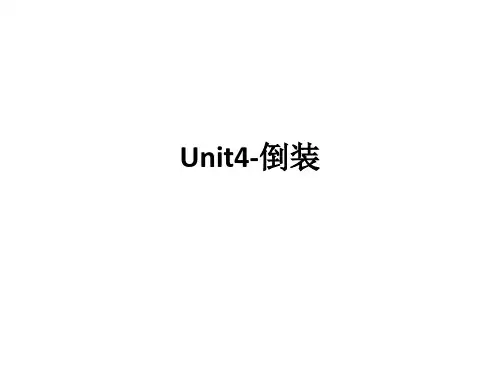
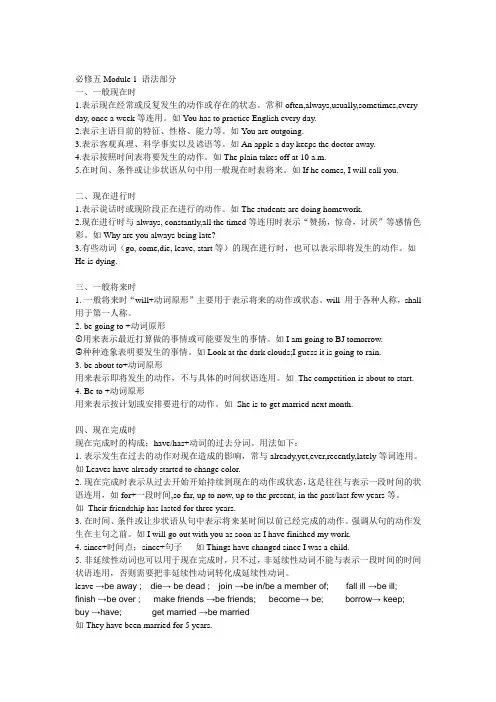
必修五Module 1 语法部分一、一般现在时1.表示现在经常或反复发生的动作或存在的状态。
常和often,always,usually,sometimes,every day, once a week等连用。
如You has to practice English every day.2.表示主语目前的特征、性格、能力等。
如You are outgoing.3.表示客观真理、科学事实以及谚语等。
如An apple a day keeps the doctor away.4.表示按照时间表将要发生的动作。
如The plain takes off at 10 a.m.5.在时间、条件或让步状语从句中用一般现在时表将来。
如If he comes, I will call you.二、现在进行时1.表示说话时或现阶段正在进行的动作。
如The students are doing homework.2.现在进行时与always, constantly,all the timed等连用时表示“赞扬,惊奇,讨厌”等感情色彩。
如Why are you always being late?3.有些动词(go, come,die, leave, start等)的现在进行时,也可以表示即将发生的动作。
如He is dying.三、一般将来时1.一般将来时“will+动词原形”主要用于表示将来的动作或状态。
will 用于各种人称,shall 用于第一人称。
2.be going to +动词原形①用来表示最近打算做的事情或可能要发生的事情。
如I am going to BJ tomorrow.②种种迹象表明要发生的事情。
如Look at the dark clouds;I guess it is going to rain.3.be about to+动词原形用来表示即将发生的动作,不与具体的时间状语连用。
如The competition is about to start.4.Be to +动词原形用来表示按计划或安排要进行的动作。
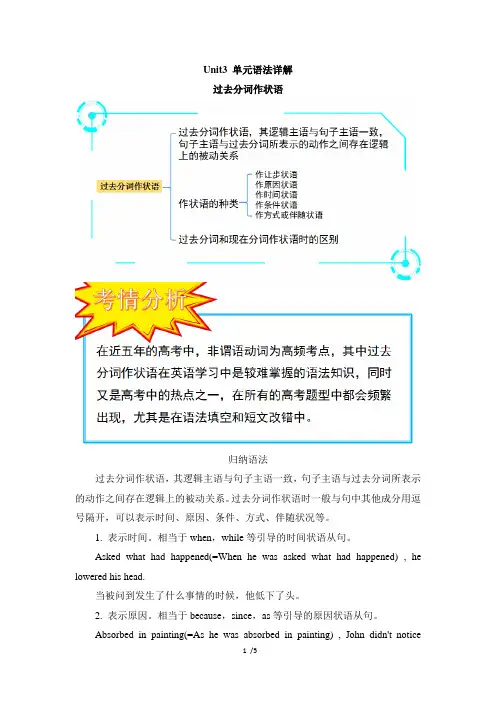
Unit3 单元语法详解过去分词作状语归纳语法过去分词作状语,其逻辑主语与句子主语一致,句子主语与过去分词所表示的动作之间存在逻辑上的被动关系。
过去分词作状语时一般与句中其他成分用逗号隔开,可以表示时间、原因、条件、方式、伴随状况等。
1. 表示时间。
相当于when,while等引导的时间状语从句。
Asked what had happened(=When he was asked what had happened) , he lowered his head.当被问到发生了什么事情的时候,他低下了头。
2. 表示原因。
相当于because,since,as等引导的原因状语从句。
Absorbed in painting(=As he was absorbed in painting) , John didn't noticeevening approaching.由于在全神贯注地画画,约翰没有察觉到夜幕降临了。
3. 表示条件。
相当于if引导的条件状语从句。
Given another hour(If I am given another hour) , I can also work out this problem.如果再给我一个小时,我也能把这道题算出来。
4. 表示让步。
相当于although,though,even if,even though等引导的让步状语从句。
Beaten by the opposite team(Though we were beaten by the opposite team) , we didn't lose heart and encouraged each other.虽然被对方的队打败了,但我们并没有灰心并且相互鼓励。
5. 表示方式或伴随。
The woman scientist entered the lab, followed by her assistants.这位女科学家进入了实验室,后面跟着她的助手。
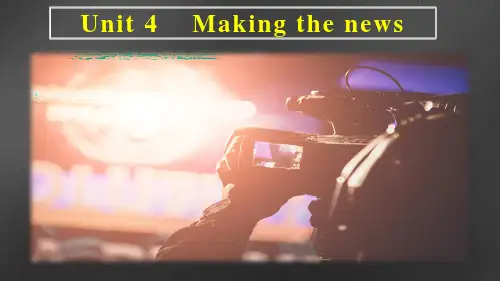
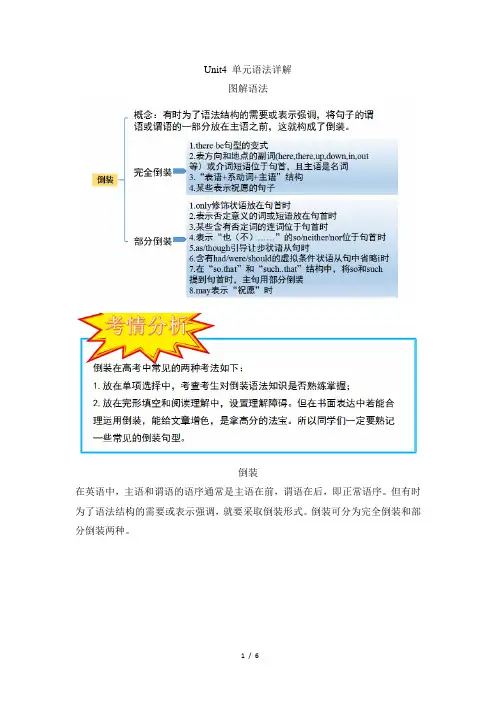
Unit4 单元语法详解图解语法倒装在英语中,主语和谓语的语序通常是主语在前,谓语在后,即正常语序。
但有时为了语法结构的需要或表示强调,就要采取倒装形式。
倒装可分为完全倒装和部分倒装两种。
一、完全倒装:指的是整个谓语提到主语前面主要有以下几种情况:1.There lie(s)/exist(s)/stand(s)/live(s)/come(s)+主语+其他,是There be句型的变体。
There is a tall building on the top of the mountain.山顶上有一幢高楼。
There stands a temple on the top of the mountain.i顶上有一座庙。
2.表示方向和地点的副词(here,there,up,down,in,out等)或介词短语位于句首,且主语是名词。
There goes the bell.铃声响了。
Here comes the bus.公交车来了。
From the valley came a cry.山谷里传来一声叫喊。
In front of the house stood a tower.房子前面立着一座塔。
3.“表语+系动词+主语”结构。
Present at the party were Mr.Green and many other guests.出席宴会的有格林先生,还有很多其他宾客。
Seated on the ground are a group of young men.坐在地上的是一群年轻人。
4.某些表示祝愿的句子。
Long live China!中国万岁!二、部分倒装:指的是将情态动词、助动词、be动词提到主语前主要有以下几种情况:1.“only+状语(从句)”放在句首时。
“only+状语”位于句首时,句子用部分倒装;“only+状语从句”位于句首时,主句用部分倒装,从句不倒装。
Only in this way can you learn English well.你只有用这种方法才能学好英语。
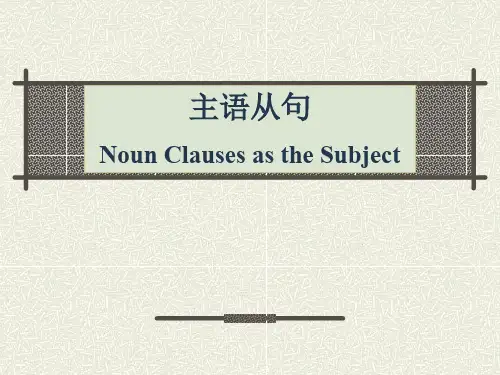
Unit2 单元语法详解过去分词作宾语补足语归纳语法英语中过去分词作宾语补足语,通常用于以下几种情况:一、过去分词用在表状态的动词keep、leave 等后面,keep/leave+n. /pron. +过去分词。
Keep your mouth shut and your eyes open. 闭上嘴巴,睁开眼睛(少说多看)。
二、用在表示“致使”意义的动词后面。
如:have,make,get等。
1. “have+宾语+过去分词”这一结构有三种含义:(1)表示“让某事被别人做”。
Have you had your films developed?你把你的胶卷让人冲洗了吗?I have my hair cut once a month.我一个月理一次发。
They are going to have the entrance hall painted white.他们准备让人把门厅粉刷成白色。
(2)表示“遇到某种不幸;受到打击;蒙受……. 损失;受……. 影响”。
While they were on holiday, they had their car broken into.他们在度假时车被撬开了。
He had his hat blown off on his way home.在回家的路上他的帽子被风吹走了。
(3)表示“完成某事(自己也可能参与)”。
I have had all my spelling mistakes corected.我已经把我所有的拼写错误都改正了。
He has had one thousand yuan saved this year.他今年已经存了一千元了。
2. 在“make+宾语+过去分词”这一结构中,过去分词表示的动作通常是表示结果含义的。
He is trying to make himself understood.他在努力把自己的意思说清楚。
三、用在感官动词或表示心理状态的动词后面。
§语法归纳过去分词作宾语补足语英语中,过去分词可以用作宾语的补足语。
能用作宾语补足语的过去分词一般都是及物动词,表示被动意义或完成意义,有时两者兼有之,与宾语有逻辑上的动宾关系,即宾语是过去分词动作的承受者。
常见的情况有以下几种:1.过去分词用在have, get, make, leave, keep等使役动词后作宾语补足语。
They kept the door locked for a long time.他们把门锁了好长一段时间。
Don’t leave the windows broken like this all the time.不要让窗户一直像这样破着。
注意:“get/have+宾语+宾语补足语(-ed)”结构可表达三种意思:1)表示主语“让别人(为自己)做某事”。
John wants to have his teeth examined this afternoon.约翰今天下午要去检查牙齿。
2)2) 表示主语“遭遇某事(不愉快或不幸的事)受到打击”。
The old man had his wrist broken in the accident.那个老人在那场事故中伤了手腕。
3)表示“某事已经完成”,主语可能参与其中也可能没有。
I had the flat painted yesterday.我的房子昨天晚上粉刷好了。
2.过去分词用在see, hear, notice, observe, smell,taste, watch, feel, find, think等感官动词后作宾语补足语。
Being ignorant of the electronic products the students are talking about, I find myself leftbehind.对学生所谈的电子产品一无所知,我发现自己落伍了。
He found his house broken into when he got back home.回到家他发现家被盗。
Unit1 -Unit3 过去分词过去分词的用法一、构成:规则动词的过去分词是有动词原形+ed构成的,不规则动词则有各自构成。
二、基本特点:过去分词在句子中的基本用法有两点:1.与逻辑主语之间是被动关系 2.表示完成的动作三、过去分词的用法:1.作表语:过去分词作表语时,一般同时具备被动与完成的含义例如:(1)The cup is broken.(2)He is retired. (3)After running,he is tired.【注意】过去分词作表语时,已经变成形容词性质,主要表示主语的状态(被动完成),而被动语态则表示动作.例如:(1) The cup was broken by my little sister yesterday. 茶杯是昨天我小妹打碎的.(是被动语态,表示动作) (2)The cup is now broken. 茶杯碎了.(过去分词作表语,表示状态)【注意】有些动词如interest, bore, worry, surprise, frighten 等通常用其过去分词形式来修饰人,表示“感到……”用-ing 形式来修饰物,表示“令人……”例如:The book is interesting and I'm interested in it. 这本书很有趣,我对它很感兴趣.2.做定语作定语用的过去分词其逻辑主语就是它所修饰的名词.及物动词的过去分词作定语,既表被动又表完成;不及物动词的过去分词作定语,只表完成.1)单一过去分词作定语,常置于其所修饰的名词之前,称作前置定语。
例如:We must adapt our thinking to the changed conditions. 我们必须使我们的思想适应改变了的情况.2)过去分词短语用作定语时,一般置于其所修饰的名词之后,相当于一个定语从句,称作后置定语。
例如:The concert given by their friends was a success.他们朋友举行的音乐会大为成功.3)过去分词短语有时也可用作非限制性定语,前后常有逗号.例如:The meeting, attended by over five thousand people, welcomed the great hero.4)用来修饰人的过去分词有时可以修饰与人有关的表情,面貌,举止行为以及感觉等,这时不能用v-ing 形式例如:The boy looked up with a pleased expression. His satisfied look showed that he had passed this exam.3.作状语作状语的过去分词在句子中多表示被动和完成两重含义。
1. characteristic用作名词,意思是“特点;特征;特性”与feature意思相近。
它也可用作形容词意为“典型的;具有…的特点的”。
Traffic jams are a characteristic of large cities. 堵车是大城市的特点。
The smell is characteristic of garlic. 这气味是大蒜的特点。
He speaks with characteristic passion. 他以特有的热情说话。
2. put forward的意思是“提出主意、计划(offer, suggest , an idea)等”。
He often puts forward some useful advice. 他常常提出一些有用的建议。
〖帮你归纳〗put的常用词组有:put aside节省(钱、时间);储蓄;把……放在一边put away储存(钱);放好put back拨慢;搁置put down放下;记下;击败;使(飞机)着陆;put off延期;推迟put on上演;穿上;戴上put out熄灭;关掉;扑灭put through接通电话;完成put up with忍受;忍耐put into action/effect/practice实施;实行3. examine 的意思是“检查;审查;诊察;考察;测验”。
The doctor examined her carefully.医生仔细地给她作了检查。
The teacher examined the students on the book they read. 老师就学生读的书考学生。
examine指的是仔细观察以了解或发现什么东西,也可用于医生检查病人,以书面或口头的形式考察学生的知识与能力。
check指的是通过检查以确保某事物正确、安全、满意或处于良好状态,核对,核实某物等。
test指的是检验和衡量某物或某人的品质、质量等,测验某人在某方面的知识或能力,还有实验、考验的意思。
高二必修5英语语法知识点高二必修5英语语法知识点:一般过去时1. 一般过去时的定义一般过去时表示过去某一时候或某一段时间所发生了的事情或存在的状态。
常与过去时间yesterday, this morning, just now, a moment ago, in May, last night / year / week, once upon a time, the other day, before …, when – clause, in the past连用。
如:What did you do yesterday? 昨天你干了什么?I met Lin Tao this morning. 今天上午我会到了林涛。
I was there a moment ago. 刚才我在那儿。
2. 一般过去时的应用(1) 表示过去某时所发生的动作或存在的状态。
如:Liu Ying was in America last year. 刘英去年在美国。
Jim rang you just now. 吉姆刚才给你打了电话。
(2) 表示过去经常或反复发生的动作。
常接时间副词often, usually, always, sometimes, every day / week, etc. 如:We often went out for a walk after supper. 我们过去常在晚饭后散步。
We usually played together. 我们通常一起玩。
3. 一般过去时对谓语动词的要求[page]一般过去时的谓语动词要用动词的过去式。
动词过去式的构成分规则变化和不规则变化两种形式,不规则变化通常需要逐个记忆,规则变化则遵循以下原则:(1) 一般在动词后加-ed。
如:play—played, offer—offered, weigh—weighed, destroy— destroyed, sign—signed.(2) 在以字母e结尾的动词后,只加-d。